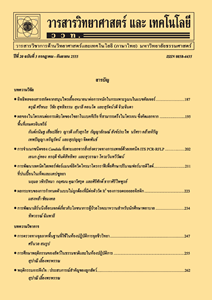ประสิทธิภาพของคาลิเปอร์ในการประเมินสภาพร่างกายแม่สุกร
Main Article Content
Abstract
Sow body condition caliper is the new tool for body condition assessment in order to aid feeding decisions during gestation. The aim of this research was to examine the accuracy of sow body condition caliper, compared with visual body condition and backfat thickness measurements, in multiparous sows under commercial conditions. The total of 561 crossbred sows between Landrace and Large White from five farrowing groups were randomly divided into three groups separated by assessing methods include (1) visually scoring, (2) measured backfat thickness at P2 position with lean meter, and (3) caliper. Sows were fed according to body condition based on each method. The body condition score 3, backfat thickness 18 to 20 mm and caliper score between 12 and 15 were assigned as the ideal body condition for pregnancy sows. The results revealed that feed management with difference methods of sow body condition assessment had influenced on number of total born piglets, number of weaned piglets, weaning weight and weaning-to-estrous interval with various results depended on farrowing groups and led to difference consequences in parity 2 and > 7 for birth weight (P < 0.05). Feeding sows during gestation based on caliper score provided the sow to have higher number of total born piglets and number of weaned piglets than visual body condition scoring (P < 0.05), but no difference in reproductive performance compared with backfat thickness measures. This demonstrated that caliper is the accuracy tool for sow body condition assessment to adjust feeding during pregnancy which may be used instead of visual scoring and backfat thickness measurement.
Keywords: caliper; backfat thickness; body condition score; feeding
Article Details
References
[2] Edmonson, A., Lean, I., Weaver, L., Farver, T. and Webster, G., 1989, A body condition scoring chart for Holstein dairy cows, J. Dairy Sci. 72: 68-78.
[3] Knauer, M.T. and Bryan, M.R., 2015, Labor Requirements and Repeatability of Sow Body Condition Measures, In Proceeding, Midwestern section, American Society of Animal Science, Des Moines, Iowa, 254 p.
[4] Revell, D.K., Williams, I.H., Mullan, B.P., Ranford, J.L. and Smits, R.J., 1998, Body composition at farrowing and nutrition during lactation affect the performance of primiparous sows: II. milk composition, milk yield, and pig growth, J. Anim. Sci. 76: 1738-1743.
[5] Schenkel, A.C., Bernardi, M.L., Bortolozzo, F.P. and Wentz, I., 2010, Body reserve mobilization during lactation in first parity sows and its effect on second litter size, Livest. Sci. 132: 165-172.
[6] Tantasuparuk, W., Dalin, A., Lundeheim, N., Kunavongkrit, A. and Einarsson, S., 2001, Body weight loss during lactation and its influence on weaning-to-service interval and ovulation rate in landrace and yorkshire sows in the tropical environment of Thailand, Anim. Reprod. Sci. 65: 273-281.
[7] Thaker, M.Y.C. and Bilkei, G., 2005, Lactation weight loss influences subsequent reproductive performance of sows, Anim. Reprod. Sci. 88: 309-318.
[8] Tummaruk, P., Lundeheim, N., Einarsson, S. and Dalin, A.M., 2001, Effect of birth litter size, birth parity number, growth rate, backfat thickness and age at first mating of gilts on their reproductive performance as sows, Anim. Reprod. Sci. 66: 225-237.
[9] Coffey, R.D., Parker, G.R. and Laurent, K.M., 1999, Assessing Sow Body Condition, Cooperative Extension Service, University of Kentucky, 2 p.
[10] SAS, 2003, SAS Online Doc 9.1.3 SAS Institute, Inc., Cary NC.
[11] Valros, A., Rundgren, M., Spinka, M., Saloniemi, H., Rydhmer, L., Hulten, F., Uvnas-Moberg, K., Tomanek, M., Krejci, P. and Algers, B., 2003, Metabolic State of the Sow, Nursing Behaviour and Milk Production, Livest. Prod. Sci. 79: 155-167.
[12] De Renis, F., Gherpelli, M., Superchai, P. and Kirkwood, R.N., 2005, Relationships between backfat depth and plasma leptin during lection and sow reproductive performance after weaning, Anim. Reprod. Sci. 90: 95-100.
[13] Skorjanc, D., Hohler, M. and Brus, M., 2008, Effect of backfat loss during lactation on weaning-to-oestrus interval of sows at gonadotropin application, Arch. Tierz. Dummerstorf 51: 560-571.
[14] National Research Council, 1998, Nutrient Requirements of Swine, 10th Ed., National Academies Press, Washington, DC, 211 p.
[15] van der Lende, T. and Schoenmaker, G.J.W., 1990, The relationship between ovulation rate and litter size before and after day 35 of pregnancy in gilts and sows: An analysis of published data, Livest. Prod. Sci. 26: 217-229.
[16] Schenkel, A.C., Bernardi, M.L., Bortolozzo, F.P. and Wentz, I., 2010, Body reserve mobilization during lactation in first parity sows and its effect on second litter size, Livest. Sci. 132: 165-172.
[17] Thaker, M.Y.C. and Bilkei, G., 2005, Lactation weight loss influences subsequent reproductive performance of sows, Anim. Reprod. Sci. 88: 309-318.
[18] Pope, W.F., 1994, Embryonic mortality in swine, pp. 53-77, In Zavy, M.T. and Geisert, R.D., Embryonic Mortality in Domestic Species, CRC Press, Inc., US.
[19] Quinioua, N., Dagorna, J. and Gaudre, D., 2002, Variation of piglets’ birth weight and consequences on subsequent perfor-mance, Livest. Prod. Sci. 78: 63-70.

